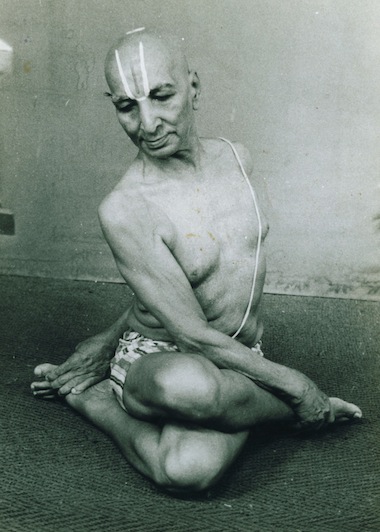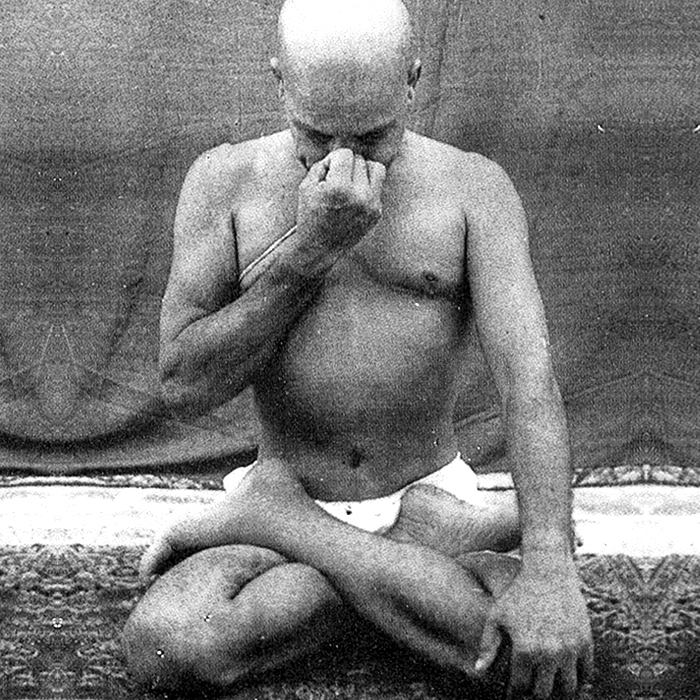Sri T. Krishnamacharya
Sri T. Krishnamacharya (1888 -1989), the progenitor of modern yoga, is widely recognized as the most significant yogic influence of the past fifty years. Many of today’s best-known yoga teachers, including Srivatsa Ramaswami, B.K.S. Iyengar, Pattabhi Jois and T.K.V. Desikachar, studied with him and modeled their own yoga styles after his practice and teaching.
Krishnamacharya was a savant and master of many topics. For 20th century Yoga, he is known as the master yogi who actualized notions of the practice that were progressively altered or lost in India. Having studied extensively for 7 years with the Naths at Mount Kailash, he understood perfectly the most ancient traditions. As an audacious renovator, Krishnamacharya adapted many of these techniques for healing, including asana assigned for individual cases, in conjunction to mental attitudes that re-enforce its efficacy, constituting a veritable “surgery” without instruments. Breath had, and still has, the function of “a scalpel” bringing about a more harmonious re-distribution of vital fluids for establishing better health, mental clarity, and spiritual growth.
He taught each student differently and created an understanding of yoga for a broad spectrum of students. By integrating the ancient teachings of Yoga and Indian philosophy with modern-day requirements, Krishnamacharya created yoga practices that are as accurate and powerful as they are practical and relevant.
You can learn more about Krishnamacharya's process and study his ancient art form at the Krishnamacharya Yoga Manidram in India and see this short video done as a tribute to his 125th anniversary. https://m.youtube.com/watch?v=bgXXFPdYKt0--
Born to Srinivasa Taraharya and Ranganayakamma of the Thirumalai family, Sri T Krishnamacharya’s lineage can be traced back all the way to Nammazhwar, a well known Vaishnavite saint. Through his father’s encouragement he became a direct descendant of Nathamuni, whose works include the Yoga Rahasya and Yoga Makaranda
At the age of 16, Krishnamacharya, decided to make a pilgrimage to alvar Tirunagair. There, upon entering a temple, he met an old man who instructed him to bathe in the river Tamraparani. When Krishnamacharya came out of the river he lost consciousness and collapsed on the bank of the river. In a trance like state he found himself in a mango grove with an old man seated under a tree. Krishnamacharya asked this old man to introduce him in the teachings of the Yoga Rahasya.
When Krishnamacharya regained consciousness, the mango grove had disappeared, but he was able to remember all the verses received while in this trance-like state. So he ran back to the temple to tell the old man who said, “Son, you are blessed. You have received the teachings of the Yoga Rahasya from Nathamuni himself." When Krishnamacharya left the temple, he realized that the old man in the temple had looked exactly like the sage that had recited the verses in the mango grove.
At age 18 Krishnamacharya went to Benares where he learned some secret and vary rare aspects of Sanskrit grammar from Brahmasri Shiva Kumara Shastri. From there he returned to Mysore and studied for 3 more years under Swami Sri Krishna Brahmatantra, head of the Paralaka Mutt.
He was the first to teach Vedic chanting to members of other castes, women and foreigners alike. He also insisted that women learn and practice all aspects of yoga at a time when yoga was considered only for men.
In the early 1930’s, Krishnamacharya was recruited by the Maharaja of Mysore to provide physical education and training to the young boys at the palace. He focused on the needs of the growing young boys through postural movements and pranayama, to develop the growing skeletal structure, musculature and energetic body of the young boys. This form was not meant for adults.
His teaching evolved throughout the duration of his long career. He revitalized the importance of the techniques of yoga to adapt the practice to each person, carefully respecting different parameters of constitution, place, sex, time, age, capacities, and aspirations. It was imperative to him that the adaptation of the practice of yoga is to the individual and not the inverse. When Krishnamacharya speaks of vinyasa particularly in his Yoga Makaranda, he defines the vinyasa as a choreographing of Mantra, Asana, Pranayama and Mudra and tells us that the ritualized Yoga derives from ancient Shastras. In other words, he never meant “vinyasa” to describe just the sequences of poses alone.
Sri Tirumalai Krishnamacharya lived to be 101 years old.
” …Like a many-faceted diamond, each side brilliant in its way. Different individuals saw different sides of him in different ways and took whatever appealed to him or her. I was fascinated by whatever he thought I should know and therefore taught me, and I found that in ásana practice, the Vinyása Krama method was most beneficial and satisfying. I am sure a few others also find it so.
With his deep scholarship, immense wisdom, and abundant compassion, Krishnamacharya reveled in making the ancient benevolent teachings accessible to ordinary mortals like us.”





